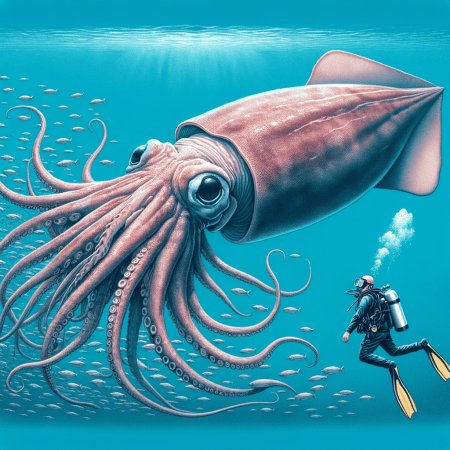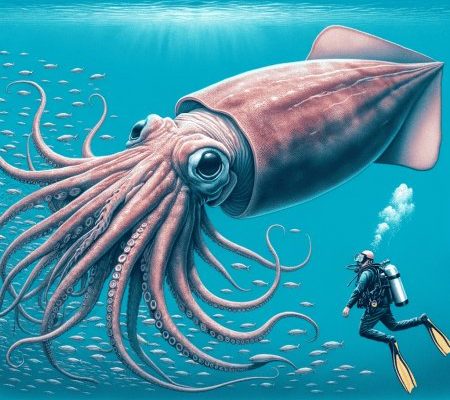
Honestly, the idea of swimming alongside a giant squid may sound thrilling, filled with an adventurous spirit. But before we dive into that enchanting world, it’s essential to know what we’re dealing with. Giant squids are elusive and deep-sea dwellers, living in the dark depths of the ocean where light barely reaches. Understanding their behavior, habitat, and safety measures for interaction is crucial if we want to connect with these enigmatic beings.
Understanding the Giant Squid
The giant squid (Architeuthis dux) has long fascinated scientists and onlookers alike. They inhabit deep ocean waters and are rarely seen by humans, which adds to their mystique. Measuring up to 43 feet in length, they have elongated bodies, large eyes (the size of dinner plates!), and, of course, those long, powerful tentacles. But there’s more to them than meets the eye.
You might be wondering about their habitat. Giant squids prefer the depths of the ocean, usually at depths between 1,000 and 3,000 feet. Because of that, they rarely encounter humans. They are thought to hunt at night, using their impressive eyesight to spot prey in the dark waters. Their diet mainly consists of fish and other squid, thanks to their remarkable hunting skills and quick reflexes.
Though they can be intimidating due to their size, giant squids are not considered a threat to humans. They’ve got an elusive nature, which keeps them out of sight and away from danger. Their primary interactions with us have been through deep-sea photography and rare encounters with marine researchers. So, despite their fearsome reputation, giant squids are more afraid of us than we are of them.
Why Humans and Giant Squids Don’t Mix
If you’ve ever watched a nature documentary showcasing these magnificent creatures, you might find them awe-inspiring. However, interacting with giant squids isn’t as simple as jumping into the water beside them. Here’s the thing: giant squids are wild animals. They have instincts and behaviors that make direct interaction risky.
For starters, these animals possess *powerful tentacles* equipped with suckers that can grip and hold onto prey. While they aren’t known to attack humans, their sheer size and strength could lead to unintended injuries. A passing human could easily be pulled toward the squid, leading to panic or distress for both the human and the animal.
Additionally, the ocean is not a controlled environment. Various factors—like water pressure, current, and temperature—can influence how a giant squid behaves. Imagine being in a dimly lit room full of unpredictable currents and sudden shifts; it’s not the safest place for a friendly encounter.
How to Safely Observe Giant Squids
So, what are some ways we can safely observe these magnificent giants without risking injury to ourselves or them? First, let’s explore a few effective methods.
- Submersibles: These are specialized underwater vehicles designed to safely navigate the deep sea. Some research teams use submersibles to study giant squids in their natural habitat.
- Remote-operated vehicles (ROVs): These are unmanned underwater drones equipped with cameras. Scientists use them to get up close and personal with giant squids while maintaining a safe distance.
- Deep-sea cameras: Placing cameras at certain depths allows researchers to capture footage of giant squids without their presence being felt, ensuring minimal disturbance.
Using these technologies, researchers can observe and gather data about the giant squid without causing harm or stress to the organism. It’s a fascinating way to learn more about these ocean giants while keeping both parties safe.
Understanding Giant Squid Behavior
To interact safely with any wild animal, understanding its behavior is key. Giant squids can display a range of actions depending on their environment and mood. Here’s a closer look at how they behave:
Giant squids are generally solitary creatures. They prefer to roam alone in the deep ocean rather than forming social groups. This makes them tough to study since they’re not often in the same place. When they do come together, it’s usually for mating, which happens deep underwater, away from prying eyes.
Furthermore, when faced with threats, they can exhibit defensive behaviors. This might include releasing ink to create a smokescreen while they escape or using their incredible speed to dash away. Understanding these behaviors not only emphasizes the importance of distance during observation but also allows us to appreciate their agility and intelligence.
The Ethics of Interaction
As we explore the topic of interacting with giant squids, we must consider the ethical implications. Should we engage with them at all? There’s a strong argument for observing them from a distance and respecting their habitat. Many scientists focus on conservation efforts rather than direct interaction.
Maintaining the balance between curiosity and responsibility is crucial. We don’t want to disrupt their natural behavior or habitat just for the sake of our fascination. Protecting the ocean and its inhabitants should always take precedence over human desire for interaction.
The Future of Human-Giant Squid Interactions
As technology advances, our ability to study and observe the giant squid continues to grow. Innovations in underwater exploration open new doors for understanding these elusive creatures. Scientists might learn more about their reproduction, behavior, and role in the ocean ecosystem.
With each new discovery, we gain a deeper appreciation for the giant squid and its importance to marine life. This understanding can guide us to interact in a way that prioritizes their well-being. It’s a thrilling journey of learning, but it’s vital to remember that the ocean is their home, and we’re merely visitors.
In Conclusion
Interacting safely with the giant squid is not only about understanding their behaviors and habitats, but also about respecting their space. These majestic creatures thrive in the depths of the ocean, where they belong. While the idea of swimming with them may evoke excitement, the best course is to observe them from a distance using technology designed for safety.
Through research and ethical conduct, we can appreciate the giant squid without intruding upon their world. It’s all about finding the right balance, ensuring that both we and the gentle giants of the deep can coexist, even if it’s from afar. So, the next time you hear tales of giant squids, remember to marvel at their beauty while respecting their mysterious lives beneath the waves.

